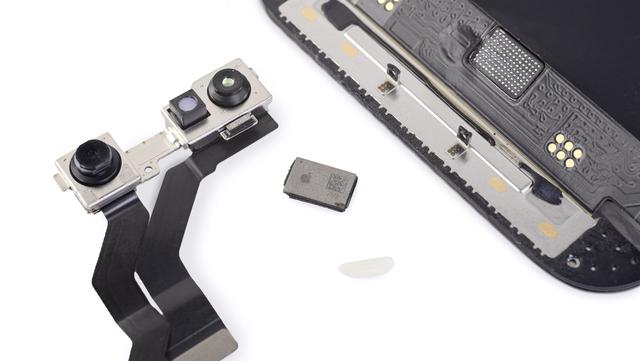iPhone 13s are a small nightmare for independent repairers. The fault of a tiny printed circuit, which makes the change of screen almost impossible without the approval of Apple.
The brand new iPhone 13 and 13 Pro are less easily repairable than previous models. Days after the new phones were released, iFixit explained how the Face ID facial recognition module could stop working after a screen replacement. This is due to a small chip that locks the screen and the biometric authentication mechanism together, a chip that can therefore prevent the second from working after changing the first.
In a long blog post published on November 4, 2021, the site specializing in the repair of electronic devices goes back at length on the operation of this chip and the challenges it presents for the market of independent repairers.
What's going on with the iPhone 13s?
The new iPhones are equipped with a tiny circuit board, which links the screen of the phone to the facial recognition module using a process dubbed “serialization”. The idea is to lock the serial number of the Face ID module with that of the screen, to ensure that the phone has not been tampered with and that no one tries to trick the facial recognition using tampered parts.
The chip that controls the pairing between the Face ID module and the iPhone screen
Source: iFixitThe problem is, this makes replacing an iPhone screen, one of the most common repair maneuvers, very complicated for independent stores. Apple Stores or repairers authorized by Apple have access to the Apple Services Toolkit 2, which allows the Face ID module to be linked with a new screen by connecting to the Apple server and declaring a new hardware “appearance”. "This gives Apple the ability to approve or deny each repair," iFixit explains.

Repair centers that do not have access to this tool must, on the other hand, either use very complex and very expensive repair techniques, or warn their customers that such a repair will cause them to lose the biometric identification mechanism. “Smaller shops could be forced to choose between spending thousands of dollars on new equipment or losing an important source of revenue,” warns iFixit. A “locking” never seen, according to the site.
The situation is very worrying for independent stores, because as an expert explains to iFixit, iPhone screen changes can represent between 35 and 60% of their income.
iPhone 13s complicate the repair process
To make matters worse, the tracks to circumvent the problem are not very practical. The first solution is to desolder the "tic-tac-sized" chip on the original screen, then solder it to the replacement part. However, the maneuver is extremely complicated and requires a microscope and microwelding tools. The chip that locks the parts together is in fact a “ball matrix” type printed circuit, which requires significant resources and a certain expertise, for results that are not always those expected.
The chip responsible for the lock is no bigger than a grain of rice
Source: iFixitThe other option is to join Apple's Independent Repair Provider Program (IRP), but for many independent businesses this comes with a number of constraints. As revealed by Vice at the start of 2020, enrolling in this program gives Apple the right to visit the stores at any time or to request information on the customers who parade there. It's also possible to join the Apple Authorized Service Provider Program, but according to iFixit both services can be described as "incredibly restrictive" from a business perspective. "This situation makes AppleCare essential for newer iPhones unless you know your local repair shop is up to the challenge," iFixit said.
Apple has assured that these serialization issues are due to a software bug that will be fixed soon. But the recent version 15.1 of iOS does not correct the problem and iFixit is surprised that this "very specific hardware bug of one of the most frequently replaced components" has not been corrected with this update. "This industry was built on iPhone screens, but that won't be the case for very long," a repairer interviewed by iFixit philosophizes.
The correction of this problem remains possible in a future update, but for iFixit the signal sent by Apple is far from reassuring.
All the news on Apple iPhone 13 Pro
